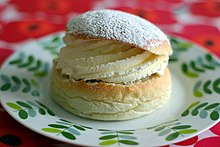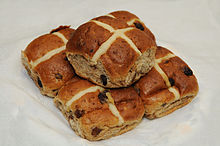Hot wakes
Hot awakening , even hot wake or Hedewigs , are a traditional pastry in German speaking countries since the late Middle Ages is detected and in North and North West Germany before the start of the pre-Easter Lent was eaten, especially from Rose Monday through Ash Wednesday . The basic form was sweet milk rolls made from wheat flour that were eaten warm. The distribution area of the hot rolls essentially comprised the sphere of influence of the Hanseatic League . There are numerous dialect names , almost all of which can be traced back to the term hot wake, most commonly Hedewäggen , Hetwegge , Heiteweggen and Heetwich .
General
There are several historical descriptions of hot rolls, although there were certain differences in the various regions. They were usually round, but other shapes were also available. The sources most frequently state that the rolls were poured with warm milk and melted butter and consumed. They have always been made by the bakeries, i.e. not baked themselves. In a dictionary for Schleswig-Holstein in 1928 there was the following description: “The hot wakes are made as round cakes with a diameter of about 10-15 cm according to a recipe that is mostly kept secret by the bakers. The main ingredients are wheat flour, butter and sugar; Various spices ( Kaneel , cardamom , currants ) are then added to this mixture (...) Spread with butter or filled with sugar, Kaneel and butter and softened in milk or egg milk, they were often eaten with every meal of the day in the first half of the 'fasting week' . "
There is a very similar definition in a Low German dictionary from Western Pomerania in 1781 , in which Heetweggen says that it is "a carnival bread, which is prepared with spices, butter and eyer in hot milk to serve as a spoon". The Holstein Idiotikon of 1800 also reports that the servants in cities like Hamburg are sent to the baker with a basket and pillow to keep the fresh baked goods warm. A distinction was made between three different types of Heetwege : those made from simple sweet dough with spices, finer milk rolls with additional raisins and, thirdly, the simplest variant, unsweetened rolls (round pieces). In Hamburg and Altona "whole circles of relatives and acquaintances were invited to this hot breakfast, on which the crown is used to put fine wines, liqueurs , hot wines or tea."
In a Swedish cookbook from 1737 there are instructions for hedvägg in the fine kitchen. Then a hole was drilled in the soft milk bun, the inside was taken out with a spoon, boiled in cream and butter and then put back into the bun, which was then eaten sprinkled with cinnamon and sugar.
distribution
Germany
In Westphalia and northern Germany , hot wakes were known regionally as early as the late Middle Ages . There is evidence for the 16th and 17th centuries. a. for Soest, Geseke , Lübbecke and Münster . There are documents for Hamburg since the 15th century; they are mentioned in 1447 and 1457 in the St. Georgs Hospital kitchen books. In Idioticon Hamburgense be Heetwegge 1755 described "hot Awakening: warm white Brodt which, kneaded with melted butter or cook-milk, and thus, the stomach is angefüllet the old naughty habit in the first fasting week. With which the old superstition was able to replace the abstention from eating meat all the more sacred. "
The atlas of German folklore gives an overview of the distribution of this pastry in 1930. “The southernmost group of documents in north-west Germany extends from the north of the Bergisches Land and the county of Mark to east Westphalia and reaches the Weser on the northern edge of the Lippe region . This diagonal from southwest to northeast touches Dortmund (south) and includes Soest , Lippstadt and Paderborn . Further north there is an accumulation of documents in the area of the former Prince Diocese of Osnabrück . ”At that time, hot wakes were known throughout Schleswig-Holstein and in Hamburg, in Mecklenburg-Western Pomerania to the Zarow , which acts as a geographical cultural border. Across this river, pretzels were traditionally eaten instead of the wake ; In Western Pomerania , in Posen-West Prussia , in Brandenburg and in the north of Saxony-Anhalt , the usual carnival pastry at that time was the Berlin pancake . In East Prussia , however, there was hot wake again, around 320 kilometers from the rest of the distribution area.
In Mecklenburg , hot wakes have been eaten for carnival at least since the 16th century. In the Greifswald / Wolgast region and in the Demmin district around 1930, a carnival pastry called "Böller" was known, which is the same pastry. This area was under Swedish influence after the Thirty Years War , the Demmin district until 1720, Greifswald-Wolgast until 1815; the word "Böller" is a German translation of the Swedish bullar for milk rolls .
The distribution pattern, which is limited to Low German language regions, is interpreted by historians as the fact that the hot wakes originally came from the Westphalia / northern Lower Saxony area and were then spread further in the course of the Middle Ages in the course of settlement movements towards the east.
Today in Sweden there is fastlagsbulle or fettisdagsbulle , which translates as Mardi Gras , which are sweet milk rolls filled with marzipan and whipped cream. These pastries were introduced by pastry shops towards the end of the 19th century. However, there were also carnival wakes in a much simpler form, which basically corresponded to the Low German hot wakes. In southern Sweden, Rose Monday is traditionally called bullamandag (wake-up Monday) . In the 18th century, people in Sweden still spoke of hetvägg . Historical evidence is the news of the death of the Swedish King Adolf Friedrich in 1771 after a meal consisting of hot rolls, sauerkraut, meat, lobster, caviar and kippers. The oldest known mention of this wake in Sweden is from 1698.
Segschneider assumes that the merchants of the Hanseatic League and German settlers brought the hot rolls to Sweden and the Baltic States , probably as early as the Middle Ages. From Riga there is a source from the 15th century.
United Kingdom
In the UK light sweet milk bread rolls are as Bun called, where there are numerous varieties. Hot cross buns are round yeast buns that contain sugar, butter, egg, raisins and various spices such as cinnamon or nutmeg . They are traditionally eaten on Good Friday and generally sold warm, mostly also eaten warm. The cross made of light dough is interpreted religiously. The word bun has been around in English since the 15th century. The seasoned spice buns appeared during the Tudor rule in the 15th century. In 1592 an edict was issued that allowed the sale of these pastries only on special occasions, namely on Good Friday, at Christmas and at funerals. Today it is eaten in the week before Easter.
Individual evidence
- ↑ a b c d e f g Ernst Helmut Segschneider : Hot wake as a carnival pastry in the Hanseatic region. In: Günter Wiegelmann, Ruth Mohrmann (eds.): Food and table culture in the Hanseatic region. Münster 1996, pp. 429-461.
- ↑ Otto Mensing, Schleswig-Holstein Dictionary, Vol. 2, Neumünster 1928, p. 701.
- ↑ Johann Carl Dähnert, Platt-German Words Book, Stralsund 1781, p. 181.
- ^ Johann Friedrich Schütze, Holsteinisches Idiotikon: a contribution to the history of folk customs, 1st part, Hamburg 1800, p. 123 f.
- ↑ quoted from Ernst Helmut Segschneider: hot wake as a carnival pastry in the Hanseatic region. In: Günter Wiegelmann, Ruth Mohrmann (eds.): Food and table culture in the Hanseatic region. Münster 1996, p. 434.
- ↑ Ernst Helmut Segschneider: Hot wake as a carnival pastry in the Hanseatic area. In: Günter Wiegelmann, Ruth Mohrmann (eds.): Food and table culture in the Hanseatic region. Münster 1996, p. 438.
- ^ Alan Davidson, The Oxford Companion to Food, 2nd ed. New York 2001, article Bun .
- ↑ Elizabeth David, English Bread and Yeast Cookery, London 1979, p. 473 ff.


